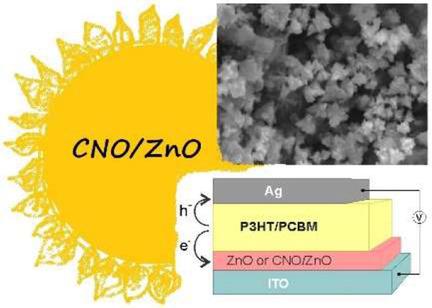当前位置:
X-MOL 学术
›
ChemNanoMat
›
论文详情
Our official English website, www.x-mol.net, welcomes your
feedback! (Note: you will need to create a separate account there.)
Carbon Nano‐Onion and Zinc Oxide Composites as an Electron Transport Layer in Inverted Organic Solar Cells
ChemNanoMat ( IF 2.6 ) Pub Date : 2019-12-05 , DOI: 10.1002/cnma.201900561 Diana M. Bobrowska 1 , Edison Castro 2 , Luis Echegoyen 2 , Marta E. Plonska‐Brzezinska 3
ChemNanoMat ( IF 2.6 ) Pub Date : 2019-12-05 , DOI: 10.1002/cnma.201900561 Diana M. Bobrowska 1 , Edison Castro 2 , Luis Echegoyen 2 , Marta E. Plonska‐Brzezinska 3
Affiliation

|
We report a facile chemical method to synthesize hybrid nanocomposites containing carbon nano‐onions (CNOs) and zinc oxide or hydroxide. The structure, surface morphology, optical properties and surface area of the CNOs were characterized by X‐ray diffraction, scanning electron microscopy with energy dispersive spectroscopy, transmission electron microscopy, thermogravimetric analysis, infrared and Raman spectroscopies, and adsorption/desorption N2 techniques. For the first time, we demonstrate the fabrication of bulk heterojunction organic solar cell devices utilizing hybrid nanocomposites containing CNOs and ZnO as the electron transport layer. This configuration showed good photovoltaic performance with maximum external quantum efficiencies of 16.5 and 48.9% and power conversion efficiencies of 0.42 and 1.49% for the pristine ZnO and CNO/ZnO (mCNO : mZnO=1 : 4) layers, respectively.
中文翻译:

碳纳米洋葱和氧化锌复合材料作为倒置有机太阳能电池中的电子传输层
我们报告了一种简便的化学方法来合成包含碳纳米洋葱(CNOs)和氧化锌或氢氧化锌的杂化纳米复合材料。通过X射线衍射,具有能谱仪的扫描电子显微镜,透射电子显微镜,热重分析,红外和拉曼光谱以及吸附/解吸N 2表征了CNO的结构,表面形态,光学性质和表面积。技术。首次,我们展示了利用包含CNOs和ZnO的混合纳米复合材料作为电子传输层的体异质结有机太阳能电池器件的制造。这种配置显示了良好的光伏性能,原始ZnO和CNO / ZnO(m CNO :m ZnO = 1:4)层的最大外部量子效率分别为16.5和48.9%,功率转换效率分别为0.42和1.49%。
更新日期:2019-12-05
中文翻译:

碳纳米洋葱和氧化锌复合材料作为倒置有机太阳能电池中的电子传输层
我们报告了一种简便的化学方法来合成包含碳纳米洋葱(CNOs)和氧化锌或氢氧化锌的杂化纳米复合材料。通过X射线衍射,具有能谱仪的扫描电子显微镜,透射电子显微镜,热重分析,红外和拉曼光谱以及吸附/解吸N 2表征了CNO的结构,表面形态,光学性质和表面积。技术。首次,我们展示了利用包含CNOs和ZnO的混合纳米复合材料作为电子传输层的体异质结有机太阳能电池器件的制造。这种配置显示了良好的光伏性能,原始ZnO和CNO / ZnO(m CNO :m ZnO = 1:4)层的最大外部量子效率分别为16.5和48.9%,功率转换效率分别为0.42和1.49%。











































 京公网安备 11010802027423号
京公网安备 11010802027423号